
Today when I reheard Rudine Sims Bishop’s phrase “mirrors, windows, and sliding glass doors” it sparked more meaning and understanding as a future teacher in comparison to when I was not. As I am becoming a future teacher of children, I want to always remember this phrase as it holds so much importance and even more so when the actions of the phrase are applied in the classroom.
Bringing books into the classroom that allow every student to see themselves brings exclusivity as it allows every student to be seen, both physically and through literature. For some it may not matter but to others it could mean the world, everyone deserves to be seen, even in literature.
Additionally, while it is important every student is to be seen through literature it is equally important to be bringing in a diverse range of books for the “windows” it allows students to look through. Meaning that when students get the opportunity to read about different cultures, ages, genders etc, it allows them to see and learn about other people’s lives and what their lives entail. Having this exposure for students can help them build empathy, understanding, kindness and a greater understanding of the similarities and differences of people’s lives.
Lastly, I love the “sliding glass doors” part of Rudine’s phrase as it makes me think that individuals and students can physically slide the door open and step onto the other side of the door (literature). To me, literature allows the reader to find themselves being put into the individual’s shoes and experiencing their life through reading/listing; it is so powerful and for students it can be a great learning experience.
Literature is so powerful and when we use it to educate or allow others to be seen, it makes it that much more powerful and special.
Linking it to the BC Curriculum:
Rudine Sims Bishop’s phrase got me thinking of some of the big ideas in the BC Curriculum under English Language Arts. Two of the ones that connect to diversity and different cultures are, “stories and other texts connect us to ourselves, our families, and our communities” and “through listening and speaking, we connect with others and share our world” (throughout the grades, the big ideas wording slightly changes but they all have the same meaning.) I believe following these big ideas and applying them to units will allow students to learn about others and their cultures, and gain an understanding that we are all the same and we are all connected. Jo Chrona stated in her First Peoples Principles of Learning wordpress that Indigenous peoples in Canada, believe that “human beings, we are all interconnected and what affects one person affects others as well” and I think that is such a great statement when it comes to how we treat others, and learning about diversity and different cultures.
This phrase also connects with the BC Curriculum core competency “Social Awareness and Responsibility” – because as educators it is important to teach and allow students to learn this competency as it will allow them to have empathy for others and support others, their communities and the environment. The more we expose them to the real world and all the lovely diversity it has, the more we can work towards a world full of connectedness, love and collaboration.
References:
Jo. (2019, August 8). First peoples principles of learning. First Peoples Principles of Learning. https://firstpeoplesprinciplesoflearning.wordpress.com/
Curriculum. (n.d.). https://curriculum.gov.bc.ca/

^ These are some great book examples that you could bring into the classroom to teach students about different cultures and allow ALL students to see themselves through literature!
Leave a Reply
You must be logged in to post a comment.